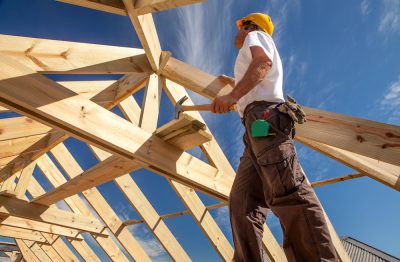The construction phase of a rehab is exciting, but it’s also one of the riskiest times of a project. Minimizing the risk of a severe injury during this phase is key for real estate investors to retain their profit and protect their business. This is true whether the investor is a DIY-er or chooses to hire out the rehab process to an experienced general contractor. To do that, it is necessary to have some basic knowledge about what injuries are common in construction and the markers of a safe job site. What are they?
Common Types of Construction Injuries
The U.S. Board of Labor Statistics reported construction as the #2 industry for fatal work injuries in a recent report. In 2017, there were 971 fatalities. Hundreds of thousands of non-fatal injuries also occur in the construction industry each year. So, what are the most common types of injuries?
OSHA’s “Fatal Four”
Most people are familiar with, or have at least heard of OSHA, the Occupational Safety and Health Administration. Congress established OSHA (Occupational Safety and Health Administration) in 1970 to “assure safe and healthful working conditions for working men and women by setting and enforcing standards and by providing training, outreach, education and assistance.” Their so-named “Fatal Four” are the most common types of fatal construction injuries:
- Falls — about one-third of construction fatalities
- Struck by Object or Vehicle – one-quarter of struck-by-vehicle fatalities involve construction workers
- Electrocutions – about 250 electrical-related fatalities occur each year
- Trenching and Excavation – the fatality rate for excavation is 112% higher than for general construction
(Statistics courtesy of https://www.osha.gov)
Common Non-Fatal Injuries on the Jobsite
Because construction is such physical work and involves many types of tools and equipment, the potential for non-fatal injuries is high. There seem to be an infinite number of ways one could be bruised, pinched, cut, and more. To name just a few, non-fatal injuries on the job site are often caused by:
- Hand & Power Tools (Hammers, screwdrivers, nail guns, saws, sanders, blow torches, utility knives)
- Heavy Equipment (Dozers, forklifts, boom lifts)
- Pollution (Asbestos, lead, drywall dust, sawdust, fumes, latex paint)
- Noise (Loud saws, sanders, drills, and other power tools)
- Flammable Liquids/Materials (Stain, paint, paint thinner)
- Slips/Trips/Falls (Slick or uneven surfaces, stairs, ladders, cluttered job sites)
- Lifting heavy objects (Boxes of tile, bathtubs, cabinetry)
- Repetitive motion injuries (Being on your knees while installing flooring, sanding, loading and unloading materials)
- Cuts and puncture wounds from materials lying around the job site (Sheet metal, nails)
- Concussions from falling objects
Investors should take a look around their job site and look critically for injuries waiting to happen. What hazards can they see lurking? How can they be remedied?
Job Site Safety Basics
Keeping a busy job site tidy can be a challenge. Tight deadlines can also tempt workers to forego safety measures to stay on schedule. Getting too comfortable with heights or power tools can have severe, sometimes fatal, consequences. On the flip side, a clean, safe job site can increase efficiency, thus maximizing potential profit. What are some of the key components of a safe and efficient work environment?
PPE – Personal Protective Equipment
Dressing appropriately for the type of work you’ll be being done is crucial. Personal Protective Equipment is an integral part of any rehabber’s uniform for keeping him/herself safe. PPE includes:
- Eye & Face Protection: Safety glasses, face shields.
- Foot Protection: Work shoes/boots with slip-resistant and puncture-resistant soles. Safety toes are made from a composite material (metal toes can still be crushed and shear off toes).
- Hand Protection: Gloves with the correct fit. Correct gloves for the type of job (paint/stain, chemicals, rough surfaces, handling boards with nails).
- Head Protection: Hard hats if in danger of falling objects from above. Hard hats should have no dents, cracks, or deterioration and should be replaced after a heavy blow or electrical shock.
- Hearing Protection: Earplugs or earmuffs in high-noise applications.
- Joint Support: Knee pads, back or knee braces, and tool belts with suspenders to take weight off the back and hips.
- Headlamp: Adequate lighting for the workspace and to help avoid slip and falls.
Housekeeping on the Job Site
Probably the simplest and most crucial task to injury prevention on the job site is keeping the worksite clean and free of hazards. Not keeping a clean job site can lead to:
- Damage to tools and equipment, materials, and the structure of the house.
- Loss of production – cleanliness and organization help efficiency.
- Fire hazards.
- Physical injuries such as slips/trips/falls, cuts, bruises, sprains, breaks, eye injuries, and more, including death.
Property investors should have a plan for:
- How trash and construction debris are removed.
- How materials will be stored.
- How tools will be organized and stored when not in use.
Jobsite Cleanliness Tips:
- Store all tools and materials not in use in their proper place.
- Clean up messes in a timely fashion – clean as you go.
- Keep walkways and driveways clear.
- Be aware of common trip hazards: electrical cords, air hoses from compressors, unfinished transitions between floor surfaces, uninstalled materials, tools that are in use, and the like.
- Work as a team to keep the job site clean and safe.
Weather Considerations – Working in the Heat
Heat-related illnesses can sneak up on workers if they are not mindful of the weather conditions they will be working in throughout the day. Heat exhaustion is not usually life-threatening, but it can lead to dizziness, headaches, and fatigue which may make a worker more susceptible to other injuries. Heat stroke can make you lose consciousness, and put strain on your heart and blood vessels, increasing the risk of heart failure or stroke. To “beat the heat”:
- Dress for success with the 3 L’s: wear Lightweight, Light-colored, Loose clothing. (Still, be mindful of anything that could get caught in machinery.)
- Use sunscreen.
- Drink fluids continuously throughout the day – don’t wait to get thirsty. Water is the best and other drinks that support electrolyte balance are good too. Stay away from anything with caffeine or alcohol.
- If possible, build up to longer periods of sun exposure gradually. Try to stay in the shade from 10 am-3 pm when the heat is the most intense and choose a place in the shade for any outdoor workstations.
- Be in the know – water, concrete, and sand reflect the sun and can increase its intensity.
- Eat a well-balanced diet with fresh fruits and veggies and avoid hot, heavy, or greasy foods.
8 Basic Jobsite Safety Tips to Share with the Crew
- Be aware of your surroundings.
- Keep a clean workspace.
- Be intentional about taking breaks to prevent fatigue and quit when you’re tired.
- Ask for help in carrying heavy objects or use tools that will help you carry awkward objects safely, such as furniture dollies.
- Properly dispose of hazardous materials (i.e. rags with paint thinner, etc.).
- Ventilate areas properly when working with flammable materials.
- Don’t remove safety features on power tools (i.e. trigger guards on nail guns, blade guards on saws).
- Dress properly for safety (i.e. heat, cold, nothing that will get caught in equipment such as jewelry).
“Nearly 6.5 million people work at approximately 252,000 construction sites across the nation on any given day.” – OSHA
OSHA – Who specifically needs to comply with their regulations?
The mission of OSHA is pretty simple. Under the OSH Act, “employers are responsible for providing a safe and healthful workplace.” It can be a little confusing as to who needs to comply with OSHA regulations, so if an investor is unsure about their status under the OSH Act, they should consult an attorney. Regardless of whether or not a person is required to report any injuries that occur at their rehab, OSHA’s advice is wise to follow, and their resources are helpful. What follows is a sampling of OSHA tools and resources that can help you achieve a safe job site.
OSHA Tools & Resources:
Prevention Tools & Resources
- Cover topics like falls, sprains and strains, carbon monoxide, electrocutions and more.
- 2-4 minutes long, sample incidents based on true stories that resulted in worker injuries.
- Link: https://www.osha.gov/dts/vtools/construction.html
“Recommended Practices for Safety & Health Programs in Construction”
- Booklet that helps employers, workers and worker representatives (unions, etc.), with a proactive framework for addressing safety and health issues on job sites.
- Includes a place to do a general self-evaluation and track progress in implementing the safety practices.
- Link: https://www.osha.gov/shpguidelines/docs/8524_OSHA_Construction_Guidelines_R4.pdf
On-Site Consultation Program for Small Business Employers
- Free and confidential.
- Helps employers assess whether there are hazards at their worksites.
- Consultants provide advice on how to comply with OSHA standards and help establish injury and illness prevention programs.
- Separate from enforcement activities and don’t result in penalties or citations.
- Link: https://www.osha.gov/dcsp/smallbusiness/consult.html
- Or call: 800-321-OSHA (6742)
OSHA Help for New Businesses: https://www.osha.gov/OshDoc/data_General_Facts/newbusinesses-factsheet.html
Want the whole “kit and caboodle”? You can find OSHA’s Construction Regulations and Standards HERE.
Licensing & Insurance
Many investors worry that hiring someone who is licensed and insured will drive up their rehab costs and make it impossible for them to turn a profit on a project. While larger construction companies may cost more because they have more overhead, hiring someone who is inexperienced or isn’t adequately insured could end up hurting an investor’s livelihood far worse than if they had simply allowed more room in the budget for construction costs. Simply put, if you can’t afford to do a project safely, it is probably not the right deal.
Final Clean-Up (The Golden Nugget)
Whether you’re the one swinging the hammer or the one calling up a GC for progress reports on a rehab project, an educated investor who is cognizant of the entire construction process can help reduce unnecessary and costly injuries. This knowledge may impact the type of deals an investor buys too; they should carefully consider how much work will need to be done and if they can afford to do it safely. Rushing the rehab process at the cost of safety or selecting a contractor without the proper experience and insurance protection can rack up a list of liabilities an investor certainly doesn’t want to pay for. We hope these tips will help real estate investors rehab safely!





